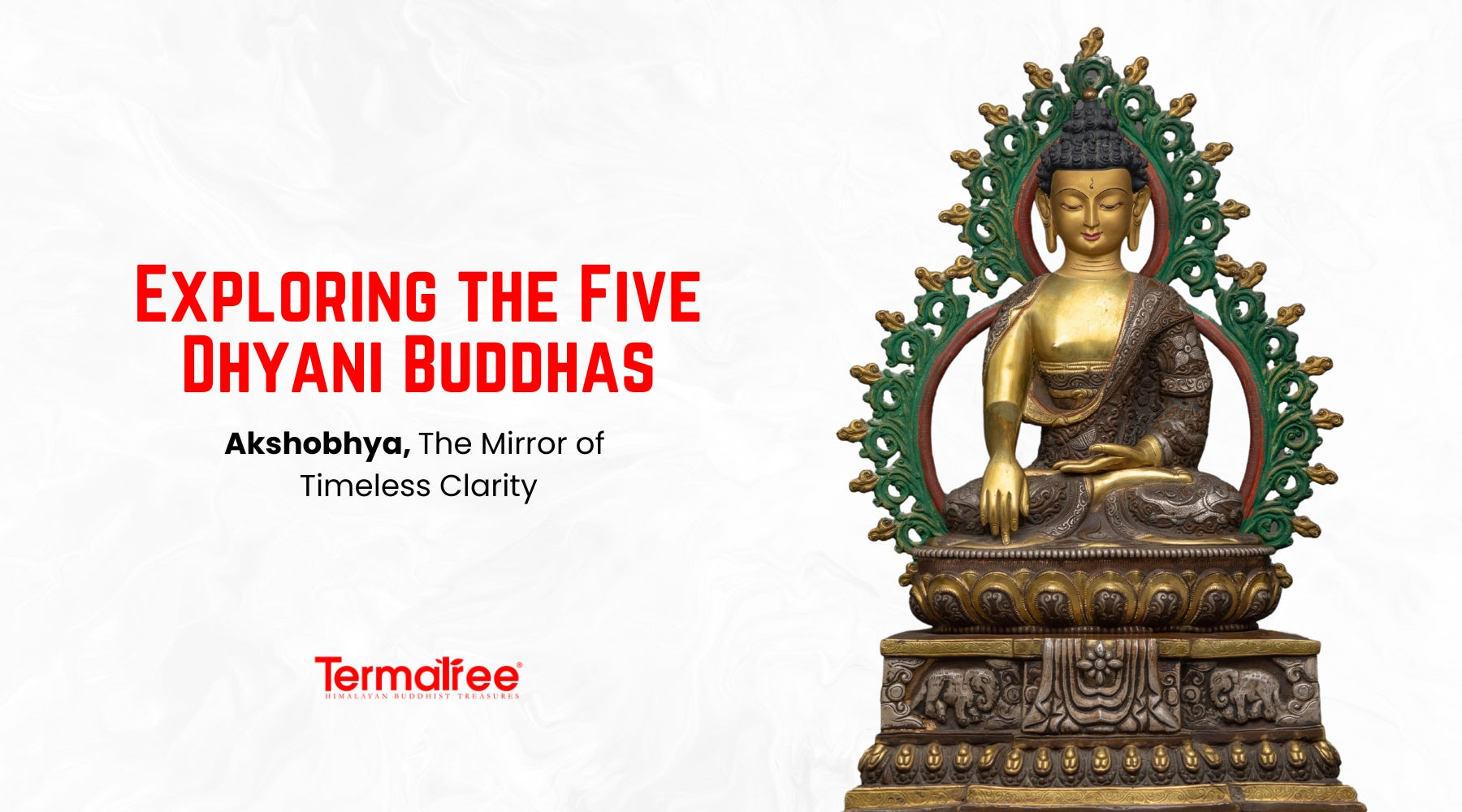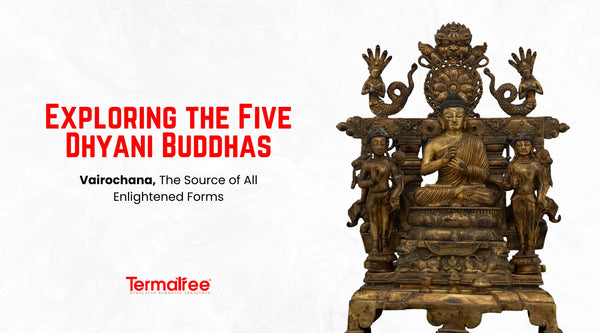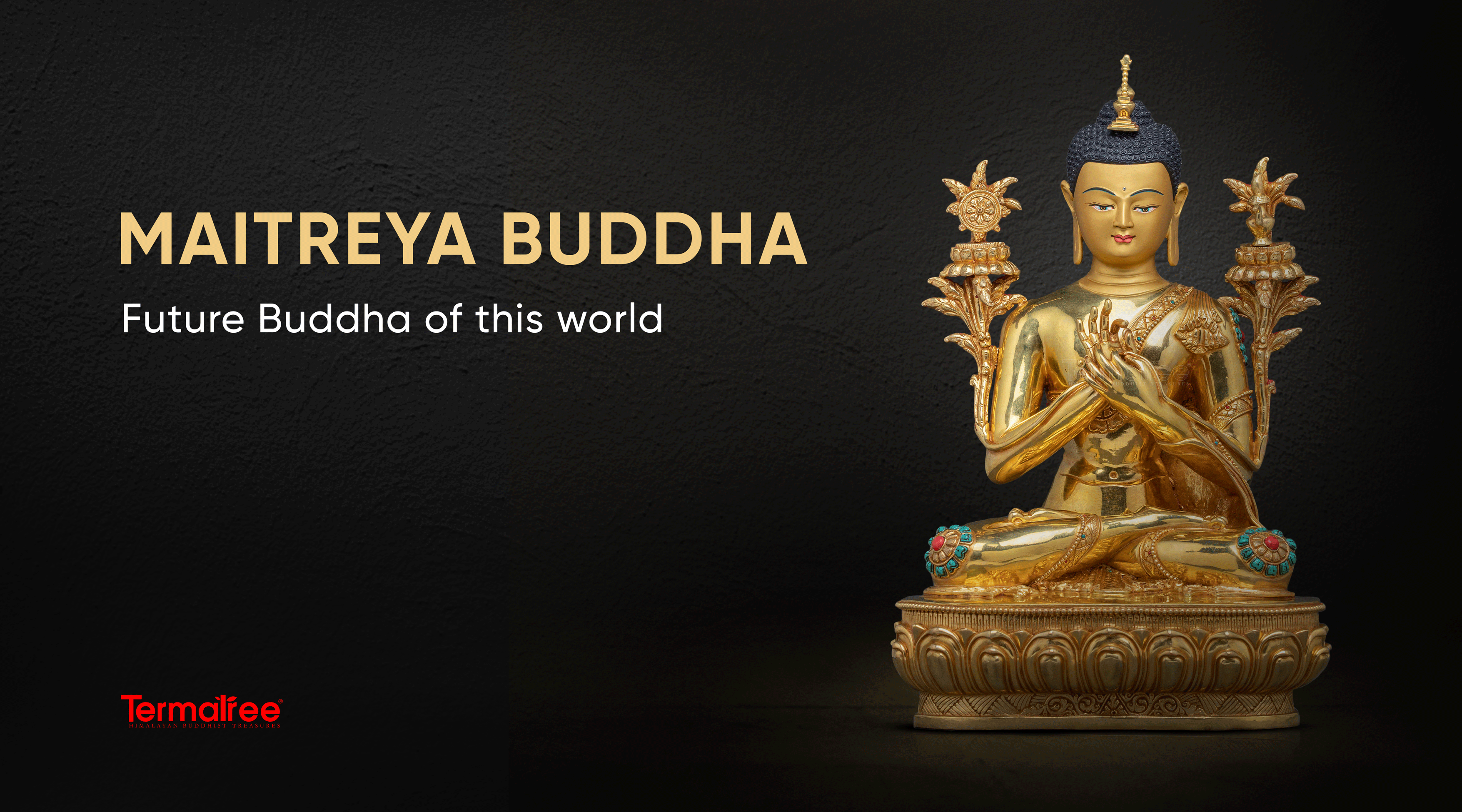Akshobhya in the Web of Enlightened Wisdom
Of the Five Dhyani Buddhas of Vajrayana Buddhism, Akshobhya, sometimes referred to as Mitrupa, symbolizes unyielding clarity along with fierce compassion. Specifically, his name means "the one who is immovable," and his response to anger, fear, or chaos can be imagined as a powerful, unshakeable mind which so many practitioners offer prayers to develop. In a world of ever-increasing emotional tumult and impulsive reactions, he presents a refuge of inner peace: a way of being not through avoidance, but through courageous facing.
Often depicted in a deep lapis blue, Akshobhya's image of solid water also symbolizes unobscured clarity, like a polished mirror, that reflects reality exactly as it is, free from distortion or narcissistic attachment. As we consider the rich symbolic imagery used to surround this Buddha, from his mudra touching the earth to the vajra that he holds, he can be more than an object of worship. He can also be interpreted as a method, a mirror, or a guide. Each visual aspect of this deity can be represented as a sequential step in the alchemical journey from aggression to wisdom, and from conflict to calm abiding. This blog will look at the various layers of his image in terms of direction, imagery, colour, mudra, and their tantric significance in relation to deeper teachings that arise from his form.
Origin of Akshobhya: The Vow of Unshakable Compassion

The story of this Buddha arises from the deep intention of a bodhisattva who had the stated commitment to overcome all anger and aversion. According to the Akshobhya Sutra, this monk decided he would never again be overwhelmed by hatred or disgust, even under the direst circumstances. He undertook countless eons of contemplation and moral discipline, despite the influences of the world, to remain steadfastly committed to this vow. In this way, his steadfast commitment to overcoming aversion shaped his eventual enlightenment as the Buddha Akshobhya — the Unshakable One. His narrative is not only a powerful example of transformation but also a dramatic reminder that steadfast internal commitment can transform even the strongest emotions into pure awareness.
Akshobhya's origin story reaffirms that enlightenment is neither some far-off miracle nor some kind of serendipitous act of favor; it is the direct result of commitment, mindfulness, and discipline. His very name implies the incredible space to remain calm and stable during uncontrollable tides of chaos — something that is applicable and rich for anyone on the path of spiritual liberation. This mythological account lays the foundation for the deity as a perennial guardian of wisdom and a powerful transformative energy for the purification of karma.
The Name and Meaning of Akshobhya
His name literally means ‘Unshakable’ or ‘Immovable’. It refers to a mind that is unscathed by the waves of anger, hatred, or aversion. In the Akshobhya Sutra, the story tells of a monk who vowed never to experience anger or disgust toward another being. He meditated without wavering until becoming an enlightened being, emerging as this deity, the epitome of calmness. This story of enlightenment is an ageless lesson for all practitioners on the truth that power lies in being unshakable.
Iconography of Akshobhya: Stillness in Blue

1. Body Color and Symbolism
The deep lapis blue color of Akshobhya's body represents water, which suggests a certain vastness, clarity, and mirror-like wisdom that reflects everything at face value. Just like water clearly and calmly reflects everything thrust upon it, His blue color embodies the mind's capacity to be vast and calm when one releases all defilements. The color also suggests the depths of inner awareness, and the prospect of open space itself, which conveys Akshobhya's immovable, unshakable mind.
2. Mudra (Hand Gesture)
Akshobhya is most commonly expressed with his right hand downwards in the (bhūmisparśa mudra) or "earth-touching gesture." This mudra expresses the Buddha inviting the Earth to witness his enlightenment experience, and represents a strong and brave presence, grounded in authentic being. His left hand rests on the kneecap while in meditation position and holds a vajra, the thunderbolt that represents indestructible knowledge and clarity. This expression displays both consistency and the transformative quality of awakened awareness.
3. Symbol: The Vajra
The vajra in the left hand of Akshobhya signifies the ultimate, unbreakable nature of awakened awareness. It means a power strong enough to destroy ignorance, yet refined enough to reveal profound truths. This relates to him, with the active transformation of negative emotions — namely anger — into clarity and wisdom as opposed to just feeling a passive calmness.
4. Posture and Throne
Akshobhya is seated in the vajra posture— cross-legged with the soles turned up— which indicates an inner stability of body, rootedness of mind, and unshakeable concentration. The vajra posture expresses the immovability of his mind, which is at ease in the midst of emotional instability. Akshobhya is typically seated on a lotus throne, which indicates spiritual purity and enlightenment.
5. Facial Expression and Gaze
His face is still, yet alert, sitting in a balance between deep reflection and alertness. Akshobhya's gaze is calm, although a vigilant awareness, able to access the thoughts and emotions of himself and others without becoming caught in them. His expression embodies that of mindful presence and equanimity.
6. Direction and Element
Akshobhya rules the east in a Buddhist mandala— the symbolic direction of dawn, awakening, and initiation. The east is where the sun rises and, in that sense, His position is reflective of the moment that the practitioner has the first light of day in which ignorance is beginning to give way to awareness. He is the Buddha facing the sun that rises, holding the assurance that no matter how dark the confusion, with effort, we can become knowledgeable beings.
He is associated with the element of water, the element of stillness, reflection, depth, and flexibility. Water is fluid and soft, but it can bore through rocks or cast covers of all things with clarity. Similarly, Akshobhya represents wisdom that is soft yet unstoppable, and reflects reality just as it is. His elemental presence is an invitation for practitioners to embody this type of wisdom: open, vast, and transparent — able to hold experience without being exhausted by it.
7. Mount and Animal Symbolism
Akshobhya's emblematic mount is the elephant, an animal held in great esteem in Buddhist traditions for its strength, stillness, groundedness, and incredible steadiness. Elephants exhibit purposeful and slow movement and have deep memories to inform their thoughts and actions. This makes the elephant well-suited as a representation for Akshobhya's essential qualities of stability, mindfulness, and the transmutation of anger into clarity. The unwavering groundedness of the elephant also symbolizes his peaceful, transcendent mind, unmoved by turbulent emotion, but existing with meditative calm.
The elephant evokes mental perseverance and intentional awareness, and calls practitioners' minds to the understanding that wisdom is not a function of speed and reaction, but is realized as one traverses their spiritual path intentionally and consciously. Most frequently placed beneath his throne or symbolically called to mind, the elephant denotes a mind's qualities of great power and gentle force, able to pierce through illusion effortlessly and patiently.
8. Attendant Figures
In thangka images and visualizations of Akshobhya, he is often surrounded by peaceful and wrathful protector deities. These protector deities are not simply decorations, and they are not simply surrounding him. They represent various inner stages of transformation along the outer and inner paths, which shows the way confusion transmutates to clear or mirror-like wisdom.
9. Symbolic Teaching
Every detail of Akshobhya’s iconography, his hand movements, blue-colored body, directions, symbols, etc., can be used as a teaching method. Whether in his practice of meditation or whatever practice they are using, Akshobhya’s form to engage, they will develop a clearer mind, the practice of patience, natural strength, and the ability to engage with a mind that is alert and aware without the reactive energy of renunciation or false enthusiasm.
Akshobhya and Vajra Family: The Thunderbolt of Wisdom
Akshobhya also leads the Vajra family (one of the five Buddha families) and is associated with the element water, the east, and when anger is finally seen as simply, and transmutated, as mirror-like wisdom. He clears space for the practitioner's ability to look inwardly rather than view/see externally. Where everyone else sees conflict or energy of anger, he is simply reflecting what is.
The vajra he holds is not a simple ritual object; it has a much more profound meaning. In Tantric, the vajra signifies skillful means, the indestructibility of reality (the firmest nature of reality), or the full tell-like (indivisible) quality of unshakable, indisturbable, insight. When you rely on Akshobya for wisdom in direct situations, it dispels the tendency to react with aggression (out-of-control). Instead, it replaces it with awareness that is conscious and calm.
Akshobhya and the Body: The Root of Stability
Within the context of tantric Buddhist anatomy, Akshobhya is associated with the root chakra (Muladhara), which is located at the base of the spine. The root chakra governs one’s ability to feel a sense of survival, security, and the basis of stability in life, all attributes that resonate strongly with Akshobhya as the immovable one. The root chakra, like Akshobhya, is fixed and steady, even while dealing with the emotions and delusions of conditional existence. It gives the practitioner a means of remaining mindful in the present to develop higher awareness of themselves and their feelings. It is significant that he connects the instinctual fear and aggression of the base chakra with the strength, clarity, and inner calm of a generated, stable experience of existence.
From the base of the spine, energy moves upward through the central channel (avadhuti) to nourish the upper channels and ultimately, the upper chakras. This upward channel is the manifestation of Akshobhya’s wisdom as the base of spiritual transformation, supporting the purification of raw, reactive emotions to awakened insight in the transformation process. Just as a foundation, however stable, healthy, or solid, is necessary for anything viable and enduring, Akshobhya reminds practitioners that the essence of spiritual evolution begins with balance in the center—specifically, a mind that is steady, undisturbed, and present.
Akshobhya and the Other Buddhas: A Web of Wisdom

To experience an understanding of this Buddha is to experience him as part of the interconnected mandala of the Five Dhyani Buddhas, who are uniquely connected with a direction, color, element, and wisdom quality that transforms one, central, core human illusion into enlightened realization.
-
Vairochana sits at the center of the mandala and evokes the wisdom of the Dharmadhatu, the luminous essence from which all wisdoms flow.
-
Ratnasambhava sees the diamond in the South and transforms human pride into the wisdom of equality, revealing the core worth of beings beyond their ego.
-
Amitabha in the West sees the fully attached, makes discriminating awareness active, and enables perception to happen without attachment.
-
Amoghasiddhi sees the jealous and envious qualities in the North, and creates the wisdom of all-accomplishing action, acting with the protection of fearless, skillful means.
By extension, Akshobhya embodies the powerful transmutation of anger into the mirror wisdom of undifferentiated awareness in the East. The direction of East, the beginning of day, leads in inner awakening, and sits as the opening to transformation in many tantric mandalas.
Mantra Practice: Invoking the Unshakable Mind
In the practice of Vajrayana Buddhism, Akshobhya is visualized and brought to mind in the meditation exercise to purify the deep-seated karmas associated with habitual negative patterns of hatred, anger, or aggression. His mantra —
"Om Akshobhya Hum"
It is a direct evocation of his unshakeable presence. This mantra may seem very simple, but it carries the energetic imprint of stillness and clarity within areas of inner chaos. When you chant the mantra with direct and sincere mindfulness, it can, over time, help settle the storm of mental turbulence, the habits of emotional reactivity, and create space in the mind for a mindful response, instead of an impulsive response. With a consistent practice, the practitioner is able to slowly take up his remarkable qualities of calmness and groundedness whilst the mind is able to reflect truth in an undistorted and impartial way, as if a mirror when briefly disturbed by the passing storms.
The Pure Land of Abhirati
Akshobhya's Pure Land is the eastern Pure Land of Abhirati, or "Land of Joyous Radiance." While the western Pure Land associated with Amitabha received far more visibility, the Pure Land of Abhirati represents transformation from the level of wisdom and ethical conduct. It is said that those who take a vow and initiate the path of non-hatred may be reborn in Abhirati, surrounded by beings devoted to the Dharma.
Some Mahayana references cite that even an encounter with Akshobhya's name or mantra can plant something quite powerful within the listener's mindstream in the form of liberation. In essence, Abhirati is a radiant landscape to symbolize a mind free from defilements and anchored in the perennial peace.
Conclusion: Becoming the Mirror
Akshobhya's calm yet powerful presence teaches us that true strength is not rooted in control, power, or repression, but in the unyielding awareness that develops through quiet presence. The imaging of this deity is rich in symbolic meaning and serves as a map for the transformation of our inner landscape. As we take the time to contemplate his form, color, and light blue radiance, the grounded gesture of his hand, the indestructible vajra of wisdom, we are given an opportunity to have a deeper conversation about our habitual tendencies and emotional reactions. He is teaching us that even the worst fits of anger and fear are not to be rejected, but rather, to be recognized, understood, and changed.
In the mandala of the awakened mind, Akshobhya holds the eastern seat; the seat of first light; the seat of awakened consciousness. He reminds us, more importantly, that transformation is not denial, but empowered, direct, fearless presence. His relationship to the root chakra, water, the elephant, the earth touch, everything, points to the same fundamental truth: stability is not stagnation; it is the beginning of deep inward movement. As we see in Akshobhya, we are reminded that stillness is not the absence of life; stillness is the ground of liberation, the place from which all realization may arise.






1 comment
Antique Buddhas
Thank you so much for sharing this beautifully insightful post on the Five Dhyāni Buddhas and the profound symbolism of Akṣobhya — the “Mirror of the Mind.” Your thoughtful exploration of how Akṣobhya represents clarity, transformation, and unwavering awareness truly resonated with me. I appreciate the care and depth you bring in unpacking these timeless teachings and making them accessible. Thank you for enriching our understanding and practice—your writing continues to inspire and guide many on their spiritual path.
Regarads,
Antique Buddhas
https://www.buddha-statues.info